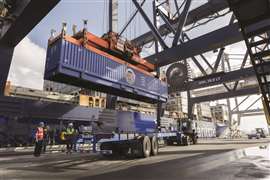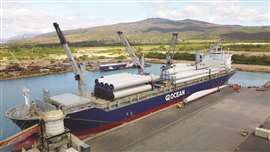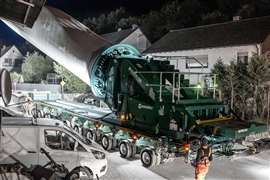How breakbulk shipping is changing
05 September 2023
Breakbulk cargo – also referred to as non-containerized or project cargo – is too large to fit in standard containers. They are neither dry aggregates nor liquid. Construction machinery (like large bulldozers), wind turbine parts (like blades and tower components) and oversized generators or transformers are all considered breakbulk cargo.
 To reduce risk and ensure your cargo arrives safely and intact, do your homework before hiring an international breakbulk carrier.
To reduce risk and ensure your cargo arrives safely and intact, do your homework before hiring an international breakbulk carrier.
Breakbulk shipping is a great option for over-dimensional cargo because it doesn’t usually require you to break down products to load them onto a vessel. That means assembling your products at the destination isn’t necessary either.
Additionally, because it’s not containerized, you don’t always need a port crane to unload it. That opens you up to more port options — including Roll-On/Roll-Off (RoRo) shipping. And because it’s all in one piece, you’ll only need one bill of lading when shipping internationally.
If you’ve been around the international shipping industry for any amount of time, you’ve probably heard both breakbulk shipping and bulk shipping. What’s the difference? Bulk shipping involves loading large amounts of loose goods onto a shipping vessel for transportation. So, the key difference between the two is the loose goods aspect of it.
Traditional bulk shipping is either considered dry bulk (like grains, salt, sugar, sand, iron ore and unmixed cement) or liquid bulk (like crude oil, petroleum and vegetable oil). Some items can’t fit in a container or ship as a standard bulk item. That’s when you may need to consider breakbulk shipping, which does come with a few challenges.
Extra handling
Breakbulk shipping is typically the best option for your oversized project cargo, but you may deal with a few common problems. Breakbulk cargo is usually large and unconventional, so it might need extra handling. That creates more risk for damage and/or vandalism.
Thanks to some innovations in breakbulk shipping technology, there are now ways to ship non-containerized cargo fully enclosed and secured. To reduce risk and ensure your cargo arrives safely and intact, do your homework before hiring an international breakbulk carrier.
 Despite the challenges with breakbulk shipping, it’s likely the best option if you’re shipping large, heavy, high-value pieces of equipment.
Despite the challenges with breakbulk shipping, it’s likely the best option if you’re shipping large, heavy, high-value pieces of equipment.
Look for project cargo freight forwarders with access to a network with new technologies. Your freight forwarder should also have an experienced team that knows the process and common risk points.
Compared to containerized shipping, breakbulk is often associated with higher costs. That’s because moving this kind of cargo demands more handling and more labor. Breakbulk cargo is priced per metric ton or cubic meter, so estimating costs is harder and requires very specific cargo descriptions, dimensions and weights. Those additional costs can often be offset by savings in other areas. Working with an experienced international freight forwarder can help you stay on budget and mitigate unexpected costs.
Additionally, if you can provide accurate drawings and lifting diagrams to your international shipping partner, they can be very helpful in the planning and permitting phases. They can also help ensure you receive a more accurate estimate for your project. Unlike container vessels, multipurpose vessel fleets don’t always operate on set schedules (like a liner service does). It can be hard to find the right type of vessel in the right position when you need to ship your cargo.
A reliable international freight forwarder can manage the transportation planning for your project. Their established relationships with ocean carriers across the world can help you secure a spot on vessels that best align with your project timeline.
Innovations on tap
Breakbulk shipping has been around for generations, but technology is transforming how we move over-dimensional cargo. Today, vessel owners are designing vessels with more capacity and lift capabilities that can handle 800 metric tons or more. This ensures large components for project shipments – like power plants – can move more safely and efficiently.
One example of innovation in breakbulk shipping is the 53-foot BreakBulk Boxx – designed so breakbulk cargo can be side-loaded and unloaded like a flatbed or flatrack. It also allows for no-transfer service for specific trade lanes. Once loaded, the BreakBulk Boxx ships like a typical container for the ocean voyage.
The BreakBulk Boxx is currently available in the U.S.–Puerto Rico trade lane or for dedicated fleet use by a shipper in defined trades. Shipping non-containerized cargo is always a bit more challenging than container shipping, but innovations are changing the way we think about breakbulk shipping.
Despite the challenges with breakbulk shipping, it’s likely the best option if you’re shipping large, heavy, high-value pieces of equipment – or other types of project cargo that won’t fit into a standard container. By working with a trustworthy international freight forwarder, you can overcome the obstacles of over-dimensional cargo shipping.
THE AUTHOR

Jay Thomassen is vice president of ATS Commercial Services, overseeing commercial and business activities and breakbulk. He has been with ATS since 2012, and partnered with ATS since 1992 in his roles with domestic and ocean transport carriers. He began his career in 1986 as a commercial driver following service in the U.S. Navy. This article was adapted from an atsinc.com blog post.
STAY CONNECTED


Receive the information you need when you need it through our world-leading magazines, newsletters and daily briefings.
CONNECT WITH THE TEAM










